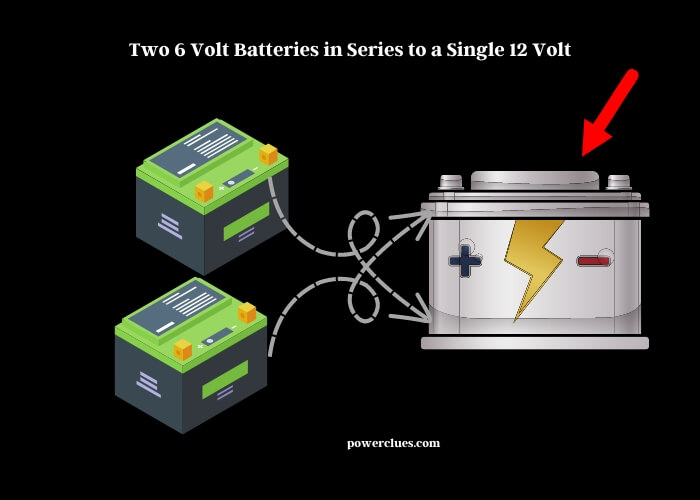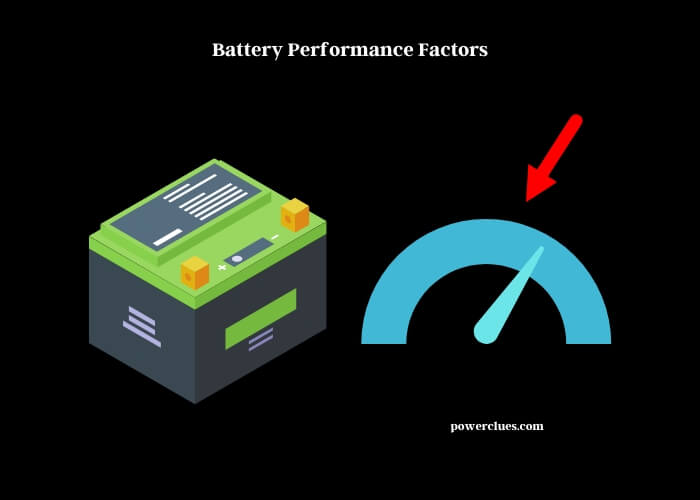Comparing Two 6 Volt Batteries in Series to a Single 12 Volt Battery
2 6 volt batteries in series can create a 12 volt output. But is it the same as using a single 12 volt battery? Let’s find out.
Have you ever tinkered with batteries, connecting them in different ways to power up your devices? Well, using two 6 volt batteries in a series connection means you’re linking them end to end. This way, their voltages add up, leading to voltage doubling. That’s how you get a combined voltage of 12 volts, much like one 12-volt battery.

Now, battery capacity remains the same even when the voltages add up. Say, if both your 6-volt batteries have a capacity of 10Ah, the series connection will still give you 10Ah but at 12 volts. It’s different from a parallel connection, where the capacities add up, and the voltage remains constant.
Considering terminal polarity is vital here. Positive connects to negative in a series circuit. So, ensuring the correct connections keeps your devices safe and working efficiently. Talking about efficiency, the discharge rate and voltage drop can vary based on how the batteries are connected and the load requirement of your device. If the load requires a steady 12 volts, then using the series-connected 6-volt batteries or a single 12-volt battery can work. Still, other factors like the age of the battery and its health can also influence performance.
Interested in learning more about how these connections work and why you might choose one setup over the other? Check out the detailed article below to get all the juicy details.
2 6 Volt Batteries in Series Vs 1 12 Volt
Basics of Battery Connections
Have you ever thought about the magic behind that little battery in your flashlight or the ones in your car? Well, the way we connect batteries can bring about a world of difference. Let’s dive right in!
Series Connection Explained
Imagine you’re holding a couple of 6-volt batteries. If you place them end to end, connecting the positive terminal of one to the negative of the other, you’ve created what’s called a “series connection.” Through this neat trick, the two 6-volt batteries act like a single battery with twice the voltage. So, instead of 6 volts, you’ve got 12!
Parallel Connection Explained
On the flip side, let’s say you link the positives together and the negatives together. This is a parallel connection. With this setup, the voltage remains the same, but the batteries last longer. Cool, right?
How Voltage and Capacity Are Affected
So, how does this all play out in real-life scenarios?
Voltage Doubling in Series Connection
When you stack two 6-volt batteries in series, it’s like giving your device a double shot of espresso. The energy is amplified, and you get a solid 12 volts of power, similar to using a single 12-volt battery.
Battery Capacity: Series vs. Standalone 12V
Now, even if the voltage doubles in a series connection, the capacity doesn’t. Think of capacity like the size of your gas tank. Whether you’ve connected two 6-volt batteries or are using a 12-volt, your tank size remains constant. Only the power delivered is different!
Connecting Batteries Correctly
Let’s be real—hooking up batteries the wrong way can be a recipe for disaster. So how do we avoid that?
Terminal Polarity Importance
Ever noticed those “+” and “-” signs on your batteries? Yep, they’re super crucial. Making sure to connect positive to negative in a series ensures your gadgets run smoothly without any hiccups.
The Anatomy of a Series Circuit
Visualize a train with two cars. The front car’s back is connected to the second car’s front. That’s kind of how a series circuit is—a continuous, single path where power flows. Simple yet effective!
Quick Comparison: Series vs. Standalone Configurations
| Feature | Series (Two 6V Batteries) | Standalone 12V Battery |
| Combined Voltage | 12V | 12V |
| Capacity | Stays the same | Stays the same |
| Connection Complexity | Moderate | Simple |
| Flexibility | High | Low |
Advantages and Disadvantages
Every choice has its ups and downs, right? Let’s weigh in on this battery conundrum.
Benefits of Using Two 6 Volt Batteries in Series
For starters, you get flexibility. If one battery dies, you can easily replace it without ditching the other. Plus, smaller 6-volt batteries can sometimes be easier to find and could be more affordable.
Drawbacks and Potential Issues
Like that one friend who’s great in small doses, two batteries can sometimes be a handful. They might require more space, more connections, and a bit more attention.
Merits of Using a Single 12 Volt Battery
One battery, one connection—it’s simple and straightforward. With a 12-volt battery, what you see is what you get: consistent power without any fuss.
Limitations to Consider
The catch? If the 12-volt battery goes kaput, you’re back to square one. You’ll need to replace the entire unit, which might pinch your pocket a bit more.
Advantages and Disadvantages at a Glance
| Point of Consideration | Series (Two 6V Batteries) | Standalone 12V Battery |
| Flexibility | High | Low |
| Cost | Variable | Might be higher |
| Space Requirement | More | Less |
| Replacement Ease | Easier for one | Replace entire unit |
Real-World Applications and Suitability
So, where might you encounter these battery setups in the wild?
When to Opt for a Series Connection
Picture this: you’re camping, and your flashlight dies. You have two 6-volt batteries but no 12-volt ones. Voila! Connect them in series, and you’re back in action. Series setups are perfect for these DIY moments or for devices with specific energy needs.
Situations Best Suited for a Single 12-Volt Battery
Think of bigger devices—like certain types of radios, RVs, or boats. They often demand the sheer power and consistency a single 12-volt battery can provide. It’s like choosing a big, hearty meal over two small snacks.
Battery Performance Factors
Alright, let’s get a tad more technical but bear with me, alright?

Influence of Battery Age
Just like wine, age matters with batteries. An older battery, whether 6-volt or 12-volt, can lose its zing over time. It’s always good to keep an eye on this!
Health and Maintenance Considerations
Keeping your batteries clean and stored in a cool, dry place can go a long way. It’s like giving them a spa day now and then!
Discharge Rate and Voltage Drop
Both these factors play a role in how long your batteries will last. Think of them as your battery’s workout routine—the better they are, the longer the battery stays fit!
Performance Metrics of Series vs. 12 Volt Batteries
| Metrics | Series (Two 6V Batteries) | Standalone 12V Battery |
| Average Lifespan | Variable | Often longer |
| Maintenance Needs | Moderate | Lower |
| Discharge Rate | Can vary | Typically stable |
Safety Precautions and Best Practices
Safety first, always! Batteries may look harmless, but they pack a punch.
Tips for Safe Connections
Ever touch the two ends of a battery and feel a tiny shock? Yeah, let’s avoid that. Always connect batteries with care, ensuring the terminals don’t touch each other.
Handling and Storage Insights
Store batteries in cool, dry places. And oh, keep them away from kids and pets. It’s like keeping your chocolate stash hidden; only this time, it’s for safety!
FAQs:
Why Are 6 Volt Batteries Better for RV?
6 volt batteries often have thicker plates which offer longer life spans. This makes them more reliable, especially for frequent RV usage where deep discharges are common.
What Is a 6V Battery?
A 6V battery provides an electrical storage unit with a nominal voltage of 6 volts. It’s commonly used in various applications, including toys, lanterns, and certain flashlights.
Are 6 Volt RV Batteries Better Than 12 Volt?
Yes, many RV enthusiasts prefer 6 volt batteries because of their durability and ability to handle deeper discharges repeatedly. The thicker plates in 6 volt batteries tend to make them more resilient over time.
Can You Use Solar Panels for a 6 Volt Battery?
Absolutely! Solar panels can charge 6 volt batteries. You just need to ensure that the panel’s output matches the battery’s voltage and that you have a suitable charge controller in place.
Does a 6V RV Battery Setup Have Advantages?
Yes, a 6V RV battery setup, especially when batteries are used in series, can offer increased amp-hour capacity, providing longer usage between charges for RV applications.
How Does Two 6 Volt Batteries in Parallel Work?
When two 6 volt batteries are connected in parallel, their voltage remains at 6 volts, but their capacity (amp-hours) is added together, giving you more power storage but at the same voltage.
Are 2 6 Volt Batteries Better Than 2 12 Volts?
It depends on the application. However, for RV use, 2 6 volt batteries in series often prove superior due to their ability to provide a consistent 12-volt output while benefiting from the durability of 6-volt battery construction.
Summary
So, between two 6-volt batteries in series and a single 12-volt battery, which wins? Well, it’s like comparing apples and oranges. Each has its charm and quirks. Your choice boils down to your needs, budget, and how hands-on you like to get with your gadgets. Either way, now you’re armed with the info to make an informed pick!
Got more questions or want to dive even deeper? There’s a treasure trove of information below. Go on, give it a read!
In the end, whether you’re an enthusiast tinkering in your garage or someone trying to get the best out of their devices, understanding the dynamics of “2 6 volt batteries in series vs 1 12 volt” can be quite the game-changer. Isn’t it amazing how such a tiny device can be so intriguing?
Remember, the world of batteries is vast and ever-evolving. So, always keep learning, stay curious, and above all, stay charged! Who knows what fascinating tidbit you might stumble upon next? After all, life’s all about making the right connections, isn’t it?
Read More:
- What is the Difference Between a Deep Cycle Marine Battery And a Regular Car Battery?
- Troubleshooting 2020 Toyota Corolla Battery Problems
- Is a Car Battery Fully Charged When You Buy It?
- Can I Use a Car Battery for My Inverter?
- How Much mAh is a Standard Car Battery?
- Troubleshooting Guide: WFCO Converter Not Charging Battery
